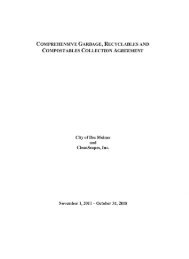CITY OF DES MOINES SHORELINE MASTER PROGRAM
CITY OF DES MOINES SHORELINE MASTER PROGRAM
CITY OF DES MOINES SHORELINE MASTER PROGRAM
Create successful ePaper yourself
Turn your PDF publications into a flip-book with our unique Google optimized e-Paper software.
Des Moines Shoreline Inventory and Characterization<br />
The sand lance’s habit of spawning in the upper intertidal zone of protected sand-gravel beaches<br />
throughout the increasingly populated Puget Sound basin makes it vulnerable to the cumulative<br />
effects of various types of shoreline development. The WAC Hydraulic Code Rules for the<br />
control and permitting of in-water construction activities in Washington State include<br />
consideration of sand lance spawning habitat protection.<br />
Shorebirds and Upland Birds<br />
Adjacent to the open waters of Puget Sound, the upland terrestrial environment provides habitat<br />
for birds, amphibians, reptiles, and insects. A variety of shorebirds utilize the nearshore<br />
environment for wintering and breeding. Seventy-five species of birds are associated with marine<br />
nearshore environments in Washington (O’Neil et al., 2001). The Washington Department of<br />
Fish and Wildlife Priority Habitat and Species (PHS) maps (2004) indicate the presence of blue<br />
heron (Status-State Monitor) nesting colony near the mouth of Des Moines Creek in Des Moines<br />
Beach Park (Segment A) (Figure 14).<br />
WDFW PHS data from 2001 also indicates the presence of pigeon guillemots (7 breeding<br />
individuals) in Saltwater State Park. WDFW personnel collected seabird colony data for the Des<br />
Moines area shoreline from 1999 to 2003 and have identified the use of cliff areas in Segments<br />
C, D, and E as containing a low of eight breeding pigeon guillemot adults in 2000 and 2003 to a<br />
high of 17 in 2002 (Evanson, personal communication, 2004) (Figure 14).<br />
Bird populations were surveyed twice in January 1995 at Saltwater State Park and fourteen<br />
species were identified including six species of diving birds (cormorants, mergansers, and<br />
grebes) and five species of surface feeders (KCDNRP, 2004). Adolfson biologists observed<br />
several bird species during an October 6, 2004 site visit including: American widgeons,<br />
American crows, several gull species, bald eagle, belted kingfisher, great blue heron, mallards,<br />
mergansers (Segment A), cormorants (Segments B and E), surf scoters (Segment C), rock doves<br />
(Segment F), and killdeer (Segment G).<br />
The PHS maps also indicate a breeding occurrence of bald eagles (federally and state listed as<br />
threatened species) is located within one mile of the Puget Sound shoreline in the vicinity of the<br />
southern Des Moines city limits. The territory for nesting eagles likely extends into shoreline<br />
Segments G. It is likely that bald eagles utilize all shoreline segments for foraging.<br />
Page 38 March 2005



